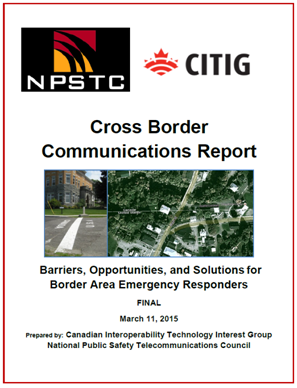A report released today by the Canadian Interoperability Technology Interest Group (CITIG) and the National Public Safety Telecommunications Council (NPSTC) cited challenges to cross-border public safety communications and recommended a number of steps to address them.
“The report is designed to clarify legal and regulatory policies, identify best practices and examples of interoperability excellence, and advance specific recommendations to enhance public safety communications at the national border,” according to a news release. “Cross border public safety communications is a complex issue that affects all first responder organizations which operate near the U.S. and Canadian border. The inability to directly communicate with other emergency responders puts both property and the lives of responders and the public they seek to protect at risk.”
“The inability to communicate across the borders is related to regulatory and technology barriers, disparate and proprietary technology solutions, and uncertainty as to whether agencies can legally execute mutual aid agreements and operational policy directives with sister agencies across the border,” the news release added.
The 61-page report includes a myriad of recommendations concerning governance, standard operating procedures (SOPs), technology, training and exercises, and usage.
For example, regarding governance the report recommends, among other things, identifying or establishing “a federal organizational body within Canada to coordinate with provincial entities to promote interoperability within Canada and across the border” and developing “model MOUs that are legally sufficient to codify relationships between U.S. and Canadian first responder organizations.”
Regarding SOPs, the report recommends working “collaboratively with the FCC and Industry Canada to understand existing regulatory processes and potential for improvements” and codifying “a radio technology standard for cross border voice communications to ensure reliable operations (e.g., when should analog be used, when P25 digital should be used, how should encryption be used, etc.).”
As for technology, the report recommends determining “available frequencies at the state/regional/provincial level to support cross border communications between U.S. and Canadian first responders. Ideally, a common interoperability frequency should be identified in both VHF and UHF bands to complement channels currently available in the 700 MHz and 800 MHz band.”- Paul Kirby, paul.kirby@wolterskluwer.com
Courtesy TRDaily

